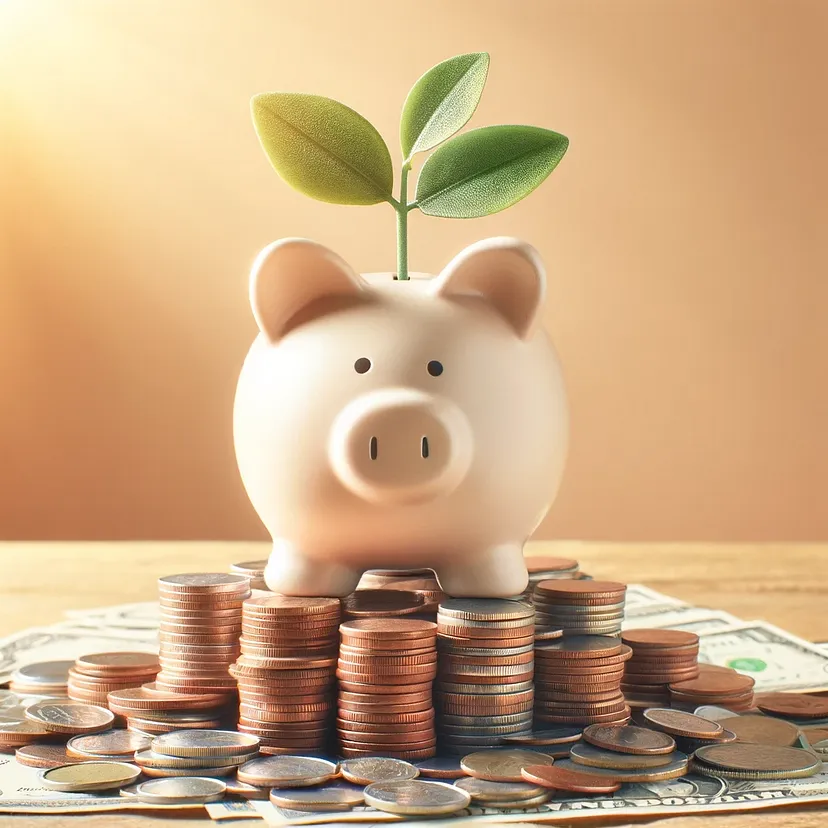Debt Management and Financial Freedom
9 Best Compound Interest Investments
You’re employed hard to your money, and it’s only right to your money to return the favor! Leveraging the very best compound interest investments is basically a way to your money to earn cash. These investments are widely known as probably the most powerful tools for growing money over the long run.
Table of contents
- 9 Best compound interest investments
- Expert tip
- What is compound interest?
- How does compound interest grow your money?
- How long will it take to double your money?
- Is compound interest the same as compound growth?
- Articles related to compound interest investments
- Choose the best investments for compound interest for you!
There’s even a preferred quote that claims: “Compound interest is the eighth wonder of the world.” It’s often attributed to Albert Einstein, however the fact-checking jury is out on whether that’s accurate.
Either way, should you don’t have time for a visit to Machu Picchu or the Great Wall of China, the wonder of compound interest can change your life irrespective of where you’re!
With the proper strategy and a mixture of the very best compound interest investments, you may reap the benefits of the facility of compound interest and maximize your returns. Let’s find out about how it really works and nine of the very best investments for compound interest!
9 Best compound interest investments
If you happen to’re in search of ways to begin growing your money, this list is an ideal place to begin! Listed below are nine of the very best compound interest investments and the best way to start leveraging them.
1. High-interest savings accounts
High-interest (also called high-yield) savings accounts offer considered one of the safest, easiest, and best investments for compound interest. For my part, everyone must have one!
Many traditional savings accounts barely pay any interest. If you happen to look up the savings account rates of interest at most brick-and-mortar bank chains, you may find numbers which can be awfully near zero…like 0.01% APY. Interest that low won’t compound very fast.
High-interest savings accounts, meanwhile, can offer yields which can be exponentially higher than the national average. Normally, you’ll find these accounts at online banks or local institutions slightly than nationwide chain banks. Since online banks have lower overhead expenses than their brick-and-mortar counterparts, they will invest extra money into paying high yields to customers.
Even higher? Lots of these banks offer each day compounding on the interest you earn. Meaning each day, the interest you earned yesterday is calculated as a part of your balance.
Then, that interest will immediately start earning interest too! All interest you accrue will often be paid as a lump sum at the top of every month.
The way to put money into a high-interest savings account
You will discover high-yield savings accounts at many various banks and credit unions. Consult Investopedia’s list here to see which savings accounts currently offer the best yield. You’ll want to also read up on the terms and possible fees for every one.
2. Certificates of deposit (CDs)
If you’ve got savings that you simply aren’t going to wish within the immediate future, consider investing in CDs! Not the music kind, though—the “certificate of deposit” kind.
So, what’s a certificate of deposit? CDs are essentially fixed-term, fixed-rate investments that require the investor to deposit a certain quantity of cash into the CD for a specified time frame. That would range anywhere from just a few months to five+ years.
Normally, the longer the term, the upper the rate of interest shall be. When the CD matures, the investor can either money it out or reinvest the funds in one other one.
Generally, CDs offer higher rates of interest than savings accounts (but not all the time—ensure to match your options). They typically also pay compound interest; you’ll have to examine the person terms to see how often it compounds.
The downside of CDs is that they aren’t as flexible as savings accounts. You’ll be able to’t just withdraw at any time when you would like and should face early withdrawal penalties should you want your money before the savings term is complete. (On the flip side, this will “force” you to get monetary savings, which is useful should you struggle with impulse spending!)
The way to put money into a certificate of deposit
Many banks and credit unions also offer CDs to customers searching for a higher-interest alternative to savings accounts. Investopedia also has a list of the highest current CD rates, in order that’s an ideal place to begin your research. Determine how long you’re willing to have your money locked up and select accordingly.
3. Treasury bonds or notes
The U.S. government offers a wide range of bond and note investments through TreasuryDirect. These are protected and stable investment decisions that permit you lock in rate for the longer term.
Also called T-bonds, treasury bonds are extremely long-term investments with terms of 20 or 30 years. Treasury notes (T-notes) include shorter terms of two, 3, 5, 7, or 10 years. You’ll be able to determine to sell bonds and notes before they mature without facing a penalty.
Each T-bonds and T-notes include a set rate of interest, paid every six months until maturity.
Nonetheless, unlike with many other compound interest investments, the interest doesn’t mechanically get added to the principal amount. As a substitute, it gets paid to you directly. That puts the compounding decisions in your hands.
If you happen to own T-bonds or T-notes and intend to make your interest compound, save up your interest payments and use them to purchase more bonds or notes. You’ll be able to buy them in increments of $100, in order soon as you’ve earned $100 in interest, you may get a brand new bond and keep the interest accruing!
For many who want their interest to compound mechanically, try EE or I savings bonds. EE bonds include fixed interest, while the interest on I bonds can change every 6 months based on the inflation rate.
The way to put money into treasury bonds or notes
Start by creating an account on TreasuryDirect should you don’t have already got one. That is the best and most direct option to research current rates and make purchases.
You’ll be able to buy EE or I savings bonds anytime. If you happen to want T-bonds or T-notes, you’ve got to attend for specific bond auction dates to purchase them.
4. Corporate bonds & bond funds
The federal government isn’t the one place you may get bonds. Corporate bonds are debt securities that individual firms issue. Bondholders essentially loan money to those corporations to assist finance their growth and operations. In exchange, they receive regular interest payments.
Bond funds are similar, but as a substitute of investing in a single bond from one company, you’re investing in a pool of bonds managed by an investment company. This helps diversify your investments, which reduces the danger you may face from anyone company defaulting on their debt.
Traditional bonds don’t offer compound interest, although you may decide to reinvest your profits in additional bonds or bond funds. Zero-coupon bonds are an exception to this rule. When you’ve got a zero-coupon bond, you don’t receives a commission periodic interest.
As a substitute, the interest compounds over the term of the bond, and also you receive all the things as one lump sum on the maturity date.
The way to put money into corporate bonds & bond funds
You’ll need an account at a brokerage (e.g. Vanguard, Fidelity, etc). There, you should purchase bonds and bond funds, in addition to stocks and other kinds of investments. Bonds are an easy option to learn the best way to start investing.
5. Money market accounts
A money market account (or MMA) is one other style of interest-bearing account offered by many financial institutions. It shares an acronym with “mixed martial arts” and may be just the thing to get your money into fighting shape!
MMAs traditionally function like a type of hybrid between checking and savings accounts. Like a checking account, they could will let you use a connected debit card and write checks. Like a savings account, they have a tendency to pay higher rates of interest, and you may expect interest to compound on a each day or monthly basis.
Some money market accounts have minimum deposit requirements, which makes them a bit less flexible than the typical savings account.
Nonetheless, there are also loads of MMAs without strict requirements. These might be an ideal alternative to traditional savings accounts!
The way to put money into money market accounts
Try which banks are offering the best rates on money market accounts without delay. Review the terms and advantages of every one to make a decision should you’d prefer to open an MMA.
6. Peer-to-peer (P2P) lending opportunities
With most of the very best compound interest investments on this list, you aren’t doing any direct lending. As a substitute, you’re engaging with a middleman (like a bank or investment firm) to handle the loan logistics when you just provide money. With peer-to-peer (P2P) lending, it gets lots more personal.
Through a P2P lending platform, you lend money on to individuals or businesses that need it. In exchange, after all, they pay you interest on the loan. You’ll be able to harness the facility of compounding by reinvesting that interest in other loans or investments.
P2P lending can offer attractive rates of interest in comparison with a few of the other options on this list.
Nonetheless, you furthermore may face an increased risk. If any of your borrowers default on their loans (aka stop paying), you’re the one who absorbs that loss.
Many peer-to-peer lenders enjoy having a more personal involvement of their investments in comparison with simply buying stocks and bonds.
As an illustration, it might probably be satisfying to assist fund a business with a mission you care about and watch them grow.
The way to invest in peer-to-peer (P2P) lending opportunities
Discover a trustworthy P2P lending platform that works for you. Some have strict requirements for his or her investors, like a certain income or net price. Listed below are a few of the most accessible P2P lending platforms for investors.
7. Dividend stocks
These next few investments are an ideal example of compounding growth since they don’t technically pay interest. I discussed dividend stocks earlier, so let’s learn more about them now.
Dividend stocks are similar to other stocks: they’re shares of a publicly traded company. The worth of a dividend stock can go up or down at any time, depending in the marketplace and the corporate’s performance.
What sets dividend stocks apart is that they often distribute a portion of their earnings to their shareholders in the shape of dividends. You’ll be able to turn this right into a compounding investment by reinvesting your dividends to buy more shares, which in turn results in a rise in your overall dividend income over time.
Nonetheless, it’s best to note that there’s no guarantee an organization will proceed paying dividends. They may determine to cut back their dividend payout and even eliminate them in some circumstances. Plus, the corporate’s stock could go down, so it’s best to not depend on this as an income source.
The way to put money into dividend stocks
You’ll be able to buy dividend stocks through any stock market brokerage. Or, you may diversify your risk by purchasing shares of dividend funds (which contain a wide range of different dividend stocks).
Dividend funds may pay you dividends as income or may mechanically reinvest the cash so it might probably compound.
8. Index funds and ETFs
Index funds and exchange-traded funds (ETFs) are very similar investments. They’re each collections of stocks, bonds, and other securities that track an underlying index (the most important example is the S&P 500 index).
The foremost difference is that ETFs are easier to purchase and sell throughout the stock market trading day similar to stocks on the open market. Index funds are only available for trading at the top of the day trading price. Also they are typically bought directly through the fund company and could have higher barriers to entry (like minimum investment amounts).
Investing in index funds and ETFs is widely considered considered one of the neatest financial moves you may make. That’s because each of them have diversification built right in.
If you happen to buy a total-market fund, you may essentially own a little bit piece of the complete US stock market!
Many brokerages will let you arrange automatic dividend reinvesting, allowing your investment to grow over time through the facility of compounding.
The way to put money into index funds and ETFs
You’ll be able to buy ETFs through any brokerage or stock trading app. Index funds can be found through their providers; most major brokerages have their very own index funds. Learn more about investing with index funds to see if it’s the proper selection for you.
9. Real estate/REITs
Do you’ve got a passion for property? Investing in real estate could yield a better return than other investments, and it might probably also provide a gradual income stream.
Traditional real estate investments require a bigger amount of capital upfront because you’ll must buy properties and get them rental-ready.
Whether you purchase residential or business property, you’ll earn income by leasing your property to tenants. Reinvest your profits by improving your properties or purchasing recent ones.
If landlord life doesn’t sound like your thing, don’t worry! There are simpler ways to speculate in real estate. REITs, or real estate investment trusts, offer a option to put money into real estate assets through the stock market.
By law, REITs must distribute at the very least 90% of their taxable profits as dividends to the shareholders. You’ll be able to reinvest these REIT profits to compound your investment.
The way to put money into real estate/REITs
To take a position in real estate or REITs start by doing all your research. For real estate, explore locations, property options, and financing options. You’ll also must do some math to determine the potential profit margins. REITs might be purchased at a brokerage similar to you’ll index funds.
All of it relies on what type of investing you ought to pursue! Discover more about real estate investing for beginners and judge the best way to construct your wealth.
Expert tip
You’ll be able to select from multiple investment options. However the foremost point is that your money isn’t just sitting there – it’s creating extra money to your future. You’ll be able to start off easy with a high-interest savings account after which work as much as more complicated investments later once you are feeling that you simply understand the method.
It may additionally be idea to diversify your money by placing it in just a few different compound interest investments, especially if it’s a great amount.
What’s compound interest?
In probably the most basic terms, you may consider compound interest as “the interest you earn on interest.”
But how does compound interest work? To assist establish our foundation, it helps to know what exactly interest is. Interest refers specifically to the fee of borrowing or lending money.
If you happen to’ve ever had a loan, you’re acquainted with paying interest. Earning interest is lots more fun, though!
So, how do you earn interest? Let’s say you select to store your money in an interest-bearing account at a bank.
The bank then uses your money to earn cash via lending and pays you a percentage of the interest while also keeping some profit for themselves. In your end, you don’t must worry about lending risk: your money is secure due to FDIC deposit insurance, and also you’ll receive regular interest payments.
Compound and straightforward interest
Interest generally is available in considered one of two forms: compound or easy.
When an investment pays compound interest, each interest payment you earn gets added to the unique amount you place in (your principal). Then, the following interest payment is calculated on that recent total (principal + collected interest).
This process continues indefinitely, allowing you to make more cash out of your investments in the long term because the interest earned compounds upon itself. (We’ll have a look at an example in the following section!)
Compounding can occur faster or slower depending on how steadily interest is calculated and applied to the investment. Interest could compound each day, monthly, quarterly, semiannually, or annually. The more often it compounds, the faster your investment will grow.
The alternative of compound interest is simple interest. Which means interest is barely calculated using the unique principal amount. Accrued interest will not be added to the calculation.
How does compound interest grow your money?
The easy answer: with compound interest, your money makes money, then that cash makes money too! That translates to constant, automatic growth.
Investing example
Here’s a fast example of how it really works:
First, you invest $1,000 into an account that pays 5% APY (annual percentage yield). To maintain it easy, we’ll say the interest is paid yearly, and also you don’t add any recent funds to the account as time goes by.
At the top of 12 months 1, you’ll earn $50 in interest, so you should have $1,050 within the account.
During 12 months 2, you’ll earn interest on that recent balance of $1,050. Meaning you’ll earn $52.50, and your balance will increase to $1,102.50.
Interest for 12 months 3 clocks in at $55, continuing to extend your balance.
This process will proceed until you withdraw the cash or something else happens, like a drop in rates of interest. If you happen to don’t touch the cash and the speed stays the identical, each interest payment must be greater than the last.
As you may see, compound interest makes your money grow with none extra effort from you. You didn’t must do anything except get monetary savings in the proper style of account and provides it time.
How long will it take to double your money?
The period of time it takes for compound interest to double your money relies on several key aspects: the speed of return, the length of the investment, and the frequency of compounding. You should use a compound interest calculator to simply crunch the numbers.
For instance, should you invest $1,000 in an account that provides a 5% rate of return, and it compounds monthly, it could take a little bit over 14 years to show that into $2,000. Doubling it to a ten% rate of interest would cut that to only over 7 years.
If you happen to proceed making contributions to the account on a monthly or yearly basis, your money will obviously add up lots faster!
Is compound interest the identical as compound growth?
People often use the terms “compound interest” and “compound growth” interchangeably. Nonetheless, there may be technically a difference. Compound interest is basically “the interest you earn on interest.”
Compound growth, alternatively, aspects within the “interest that you simply earn on interest” and represents the typical rate of growth in your investments based on the reinvestment of interest earned and dividends, in addition to investment appreciation over a time frame e.g. multiple years.
One thing to take into account with regards to compound growth is that each one investments can grow, but not all investments pay interest. e.g. Some investments earn dividends and may appreciate.
For instance, Let’s say that as a substitute of investing in an interest-bearing account, you purchase dividend stocks. You continue to get regular payments based on a set percentage rate, which may then be reinvested to make it easier to buy more stocks or earn extra money.
Nonetheless, the cash you get from dividend stocks isn’t technically “interest”—it’s a “dividend yield.” Which is an annual payment to shareholders based on the present price of the investment.
Since compound interest and compound growth have the same mechanism, our list of best compound interest investments will include multiple investment types, not strictly interest-bearing ones. So long as they’re expected to grow often and will let you reinvest the cash, these investments can all help compound your wealth!
Articles related to compound interest investments
If you happen to enjoyed this text on compound interest investments, try this related content:
Select the very best investments for compound interest for you!
What are the very best investments for compound interest to your situation? That part’s as much as you! For the very best results, you may leverage a mixture of the very best compound interest investments.
To start out, I like to recommend opening a high-yield savings or money market account to store your emergency fund. You may also use these for every other savings you ought to keep stable and simply accessible, like sinking fund categories.
After that, you may open a retirement savings account and begin filling it with investments like dividend funds, ETFs, bonds, etc.
You’ll be able to determine to devote any extra cash to treasury bonds, real estate investments, CDs, P2P lending, or whatever else is smart to your financial situation.
Irrespective of what direction you go in, it’s vital to do your research before investing.
There are risks related to every kind of investments, and you ought to be confident in your decisions. (Take our quiz to learn the way risk-averse you’re.) Knowledge is power, so keep researching and learning more!
The post 9 Best Compound Interest Investments appeared first on Clever Girl Finance.





